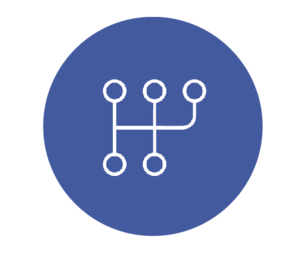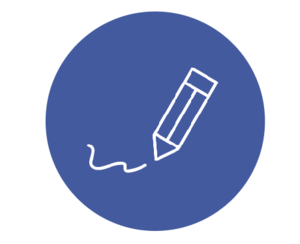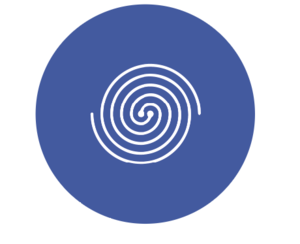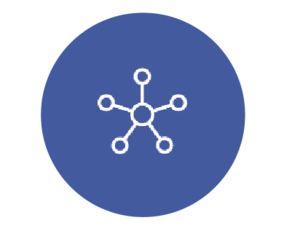More applications
Secure anonymous transmission
 In communications, anonymity is a property where the identity of the sender and/or the receiver of a message needs to be kept secret. It is of importance in such communications as review processes, job applications, surveys and elections. One classical solution for anonymous transmission is to use a trusted third party that relays the message from sender to receiver while removing or not revealing any information about the sender. Other classical solutions rely on using many different intermediate parties who transfer the message, making it more difficult to find the sender’s identity.
In communications, anonymity is a property where the identity of the sender and/or the receiver of a message needs to be kept secret. It is of importance in such communications as review processes, job applications, surveys and elections. One classical solution for anonymous transmission is to use a trusted third party that relays the message from sender to receiver while removing or not revealing any information about the sender. Other classical solutions rely on using many different intermediate parties who transfer the message, making it more difficult to find the sender’s identity.
Quantum anonymous communication is a protocol that guarantees that a sender can send a message to a receiver, both being part of a bigger group, in such a way that the receiver or anybody else cannot tell who was the sender. It also guarantees that the information that was sent has not been tampered with, and that the receiver is only known to the sender.
In quantum anonymous transmission a multi-party entanglement is set-up first, e.g. by randomly selecting one party to set-up entanglement with all other parties in the network. Then the sender designates a receiver, by sending classical information to all partners. If all parties in the group follow a certain protocol using this information, an entangled link between sender and receiver becomes established. This link can then be used to send information anonymously to the receiver and the information is protected from an eavesdropper. Furthermore, dishonest participants (who do not follow the protocol) will cause the mechanism to abort, but no information about the sender, the receiver or the message can be learned from this.
High-precision timing for Very Large Base Interferometry (VLBI)
 High-precision timing plays an important role in applications such as Global Positioning Systems (GPS), gravitational wave detection systems and radio-astronomy systems based on Very Large Base Interferometry (VLBI). The VLBI system consists of several radio telescopes that observe the same part of the sky. The larger the distance between the telescopes (this distance is called the interferometry base), the better these telescopes can distinguish two closely spaced sky objects, like pulsars or quasars. Ultimately, you would like to place the radio telescopes on the opposite sides of the Earth, or, even better, to put them on the satellites positioned above the opposite sides of the Earth. However, for correct results, the local clocks of the telescopes in the VLBI system should be synchronized, and should maintain this synchronization for a long time.
High-precision timing plays an important role in applications such as Global Positioning Systems (GPS), gravitational wave detection systems and radio-astronomy systems based on Very Large Base Interferometry (VLBI). The VLBI system consists of several radio telescopes that observe the same part of the sky. The larger the distance between the telescopes (this distance is called the interferometry base), the better these telescopes can distinguish two closely spaced sky objects, like pulsars or quasars. Ultimately, you would like to place the radio telescopes on the opposite sides of the Earth, or, even better, to put them on the satellites positioned above the opposite sides of the Earth. However, for correct results, the local clocks of the telescopes in the VLBI system should be synchronized, and should maintain this synchronization for a long time.
The synchronization of classical atomic clocks is done by exchanging timing signals. The accuracy of the synchronization is limited by the uncertainty in the timing, which by itself is limited by the signal- to-noise ratio of the timing signals, but also by fluctuations in the transportation time of the signal between the clocks (timing jitter). Clock synchronization of GPS systems using satellite-based timing synchronization achieves a timing accuracy of about 500 picoseconds (2 billionth of a second). Fiber-based timing synchronization protocols achieve a timing accuracy of a few picoseconds.
Even better timing accuracy can be achieved by using entangled photons to synchronize distant clocks. Such quantum clock synchronization protocols have been investigated for bi-partite and multi-partite synchronization. Experimental tests with quantum clock synchronization have shown timing accuracies below 1 picosecond, which is about 500 times more precise than classical satellite-based timing synchronization. Theoretically, quantum clock synchronization can improve accuracy with another factor of 100, which would greatly enhance the performance of the applications relying on distant clock synchronization, such as gravitational wave detection as well as many other applications.
Cheating an online game of bridge
 While it is debatable whether ‘mind sports’ are actual sports, the International Olympic committee recognizes two of them as such: chess and bridge. Bridge is played all around the world, but the popularity of the online version may vanish quickly once a quantum internet arrives. After all, who would want to play a game in which the opponents can easily cheat? The advent of a quantum internet calls for the rules of bridge, as defined by the World Bridge Federation, to be updated in order to prevent cheating in the online version. In bridge there are four players named North, East, West and South. North & South and East & West form a team. Cards are shuffled and distributed equally amongst the four players. The game starts with an auction and finishes with playing the hand. In the auction, each player bids on the number of tricks they think they will be able to get. The goal of the game is to guess the minimal number of tricks you can obtain as a team and take on the optimal contract to achieve that. This auction is tricky, because so many different deals are possible. However, it has been shown that with the help of preshared entanglement, team members can share information about the cards they hold more efficiently and are therefore able to cheat in the online version of bridge.
While it is debatable whether ‘mind sports’ are actual sports, the International Olympic committee recognizes two of them as such: chess and bridge. Bridge is played all around the world, but the popularity of the online version may vanish quickly once a quantum internet arrives. After all, who would want to play a game in which the opponents can easily cheat? The advent of a quantum internet calls for the rules of bridge, as defined by the World Bridge Federation, to be updated in order to prevent cheating in the online version. In bridge there are four players named North, East, West and South. North & South and East & West form a team. Cards are shuffled and distributed equally amongst the four players. The game starts with an auction and finishes with playing the hand. In the auction, each player bids on the number of tricks they think they will be able to get. The goal of the game is to guess the minimal number of tricks you can obtain as a team and take on the optimal contract to achieve that. This auction is tricky, because so many different deals are possible. However, it has been shown that with the help of preshared entanglement, team members can share information about the cards they hold more efficiently and are therefore able to cheat in the online version of bridge.
Secure voting
 Using quantum entanglement and quantum key distribution, different flavors of quantum secure anonymous voting can be realized, such as simple yes/no votes with multiple parties or more complex balloting systems, with ballot verification, casting multiple ballots, etc. Note that different protocols can have very different security characteristics or assumptions.
Using quantum entanglement and quantum key distribution, different flavors of quantum secure anonymous voting can be realized, such as simple yes/no votes with multiple parties or more complex balloting systems, with ballot verification, casting multiple ballots, etc. Note that different protocols can have very different security characteristics or assumptions.
Quantum digital signature
 Your passport, your debit card, your credit card, your driver’s license, your employment contract and many other official documents in your life need your signature to become valid. An equivalent of the handwritten signature in the digital world is called a digital signature. A quantum version of the digital signature exists: a quantum digital signature. It allows you to identify yourself in a secure way by using quantum cryptography. Therefore, it becomes impossible to pretend to be someone you are not, making this a very secure version of your signature.
Your passport, your debit card, your credit card, your driver’s license, your employment contract and many other official documents in your life need your signature to become valid. An equivalent of the handwritten signature in the digital world is called a digital signature. A quantum version of the digital signature exists: a quantum digital signature. It allows you to identify yourself in a secure way by using quantum cryptography. Therefore, it becomes impossible to pretend to be someone you are not, making this a very secure version of your signature.
Gravitational wave detection
 In 1916 Albert Einstein predicted that massive energetic events in the universe, like colliding neutron stars, cause ripples in space-time. In his theory, these waves travel through the universe like ripples on a pond, and pass our own planet. In principle, these waves can be measured at the Earth’s surface, but the wiggling of space-time on Earth would be very small, smaller than the size of an atom. The measurement of gravitational waves gives us essential information about the creation of the universe, the life cycle of galaxies in the universe and a validation of Einstein’s theories.
In 1916 Albert Einstein predicted that massive energetic events in the universe, like colliding neutron stars, cause ripples in space-time. In his theory, these waves travel through the universe like ripples on a pond, and pass our own planet. In principle, these waves can be measured at the Earth’s surface, but the wiggling of space-time on Earth would be very small, smaller than the size of an atom. The measurement of gravitational waves gives us essential information about the creation of the universe, the life cycle of galaxies in the universe and a validation of Einstein’s theories.
Because these signals are so small, it took almost a century before mankind was able to build systems sensitive enough to detect gravitational waves: in 2015 the LIGO observatory was the first to detect gravitational waves. The LIGO observatory consists of two large interferometers placed thousands of kilometers apart. Each of these interferometers is designed to measure tiny changes in space-time caused by gravitational waves. A basic interferometer consists of a laser, a beam splitter that splits the light from the laser in two directions, two arms (each 3 kilometers long), mirrors at the end of each arm and a detector. The light reflected from both mirrors travels back to the beam splitter where it recombines (interferes) and hits a detector. Because the light travelling through the arms are waves, the detector shows a specific interference pattern. This pattern is extremely sensitive to changes in the length of the arms. The LIGO interferometers are designed to measure changes in the length of the arms much smaller than the size of an atom. This is sensitive enough to detect gravitational waves.
The sensitivity of these interferometers can be further increased by using squeezed light. Squeezed light is a quantum-mechanical effect by which the noise limit of the phase of the signal can be reduced to values lower than would be possible with classical light, by squeezing some parameters of the light (the phase quadrature) at the expense of increasing the noise in other (the amplitude quadrature).
The LIGO detectors are based at different locations around the world to validate that a detected event is really caused by a gravitational wave. Additionally, timing synchronization allows for various control systems along the optical arms of each interferometer, which is crucial for the operation of the LIGO system. This synchronization is done using the most accurate atomic clocks and the GPS system. Improving the synchronization using quantum communication systems will significantly improve the system.
Distributed quantum computing
 Multiple small quantum computers can be linked together in a distributed quantum computing system via quantum connections. Note that a cluster of quantum computers connected by classical connections cannot be considered a distributed quantum computer, because entanglement between the computers is required to obtain an increase of computational power. Small quantum computers linked by quantum connections could be a stepping stone to future large-scale quantum computers.
Multiple small quantum computers can be linked together in a distributed quantum computing system via quantum connections. Note that a cluster of quantum computers connected by classical connections cannot be considered a distributed quantum computer, because entanglement between the computers is required to obtain an increase of computational power. Small quantum computers linked by quantum connections could be a stepping stone to future large-scale quantum computers.